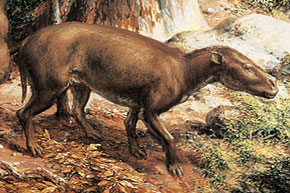Eocene
Eocene Epoch (55.8 – 33.9 MYA)

An extract from Rudolph F. Zallinger’s mural “The Age of Mammals,” showing reconstructions of Eocene mammals. From left to right these are Pelycodus, an early primate; the predatory creodont Oxyaena; Paramys, a primitive rodent; the large pantodont Coryphodon; and the early perissodactyls Hyracotherium and Paleosyops. © Yale University
Lasting nearly 22 million years, the Eocene is the longest epoch of the Cenozoic. During this time, the first ancestors and close relatives of modern mammal species appeared. Many of these modern mammal groups appear at the beginning of the Eocene, a period of dramatic global warming called the Paleocene-Eocene thermal maximum.
Among the mammal groups that first appear in the fossil record during this period are the perissodactyls, artiodactyls, proboscideans, rodents, and primates. It is thought that the intense global warming allowed warm-adapted mammals to migrate between continents via land connections at very high latitudes. Improved global dispersal allowed mammals to spread into areas in which fossils were being preserved. One such place was what is now the Rocky Mountain basins of North America. Uplift of the Rockies, which began in the Mesozoic, continued in the Eocene. It was these conditions that led to abundant preservation of fossils in this area, including the earliest perissodactyls.
Early perissodactyls, such as the horse relative Hyracotherium, appear right at the very beginning of the Eocene. Hyracotherium and other perissodactyls probably originated in Europe or Asia and migrated from Asia to North America via a high latitude land bridge. The Eocene is the heyday of the perissodactyls, with more kinds of this ungulate group present than in any other epoch. As the Eocene progressed, the Earth's temperature gradually cooled. The rainforest-like habitats that covered much of the continents gave way to more open woodland.
By the end of the epoch, the planet was much cooler, seasons were more extreme, and Antarctic ice caps had begun to form. Many of the more primitive mammalian groups that dominated the Paleocene went extinct and were replaced by more modern mammal groups of mammal such as the perissodactyls. One of the best sites for late Eocene mammal fossils is an extensive area of arid, heavily-eroded terrain covering parts of Nebraska, South Dakota, and Wyoming, which is known as the White River Badlands.


